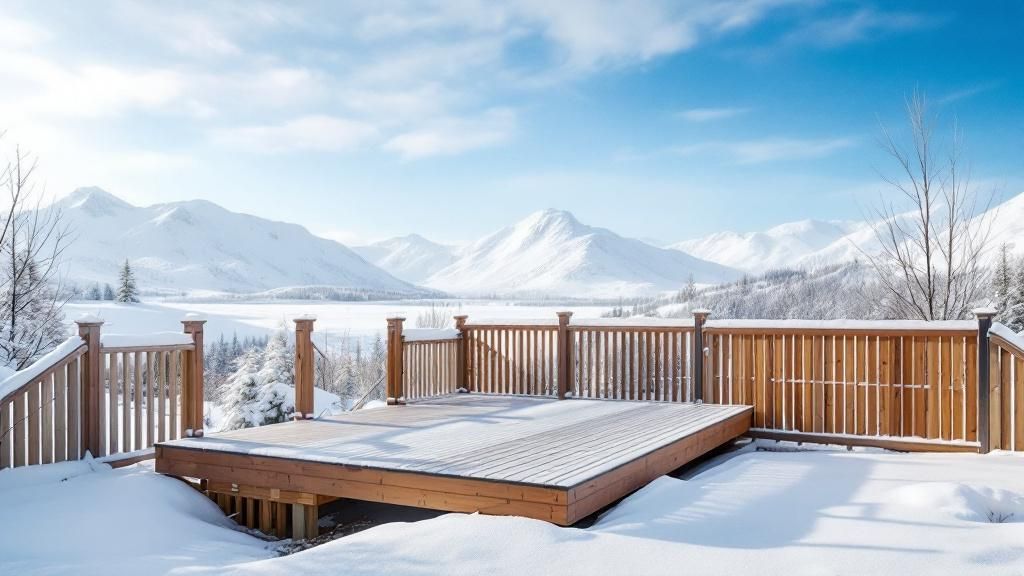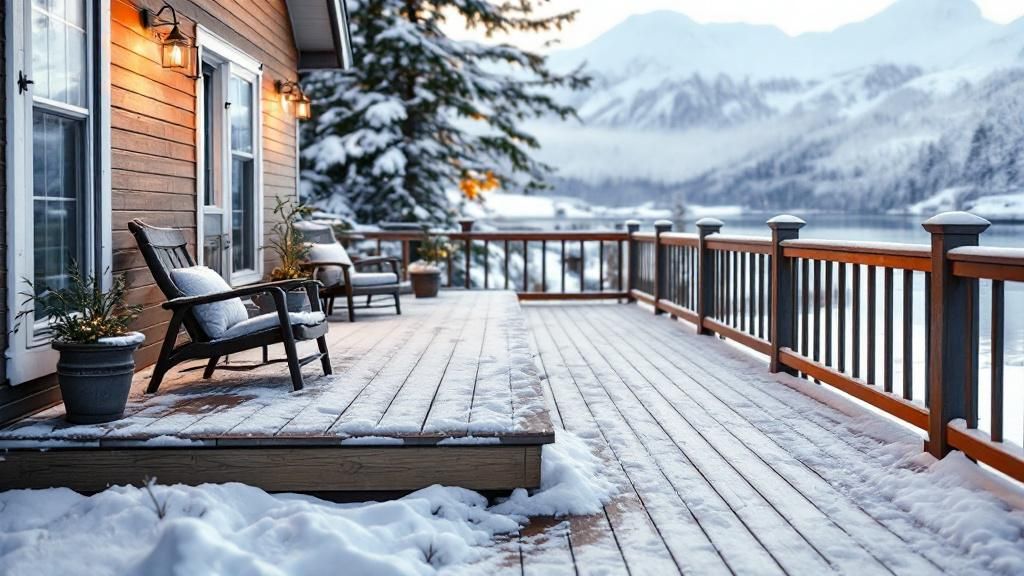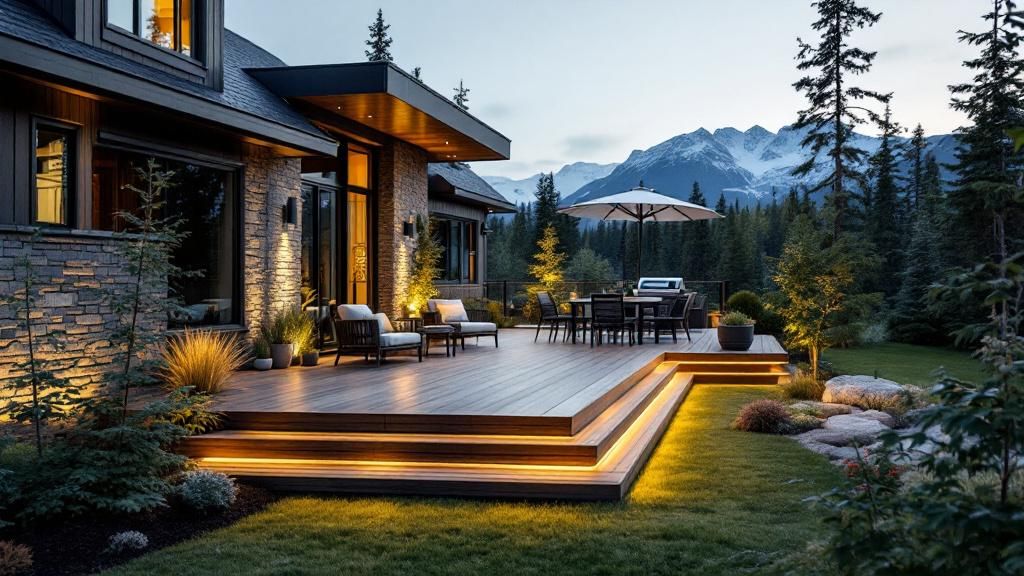
Built to Last: Decks and Fences Designed for Anchorage’s Harsh Climate
Key Takeaways
- Decks and fences in Anchorage must withstand extreme weather conditions.
- Using sturdy materials is crucial for long-lasting outdoor structures.
- Regular upkeep prevents damage from harsh climates.
- Proper design and construction techniques enhance structural resilience.
- Choosing the right materials can reduce repair costs over time.
In Anchorage, where the climate is harsh, having a deck or fence that withstands the elements is crucial.

Why Outdoor Structures in Anchorage Demand Specialized Design
Anchorage’s climate is no joke. With freezing temperatures, heavy snow loads, and frequent freeze-thaw cycles, outdoor structures in this region face conditions that can quickly wear down traditional construction. That’s why designing decks and fences for Alaska requires a different mindset than in milder parts of the country.
Specialized design starts with understanding local environmental stressors. For instance, frost heave can shift improperly installed posts, leading to warped decks and leaning fences. Moisture-resistant materials and proper drainage are essential to prevent rot, mold, and deterioration from prolonged exposure to wet conditions.
Wind resistance also plays a role. Anchorage sees powerful wind gusts, meaning your fence and deck must be anchored and reinforced for stability. Every design detail—post depth, board spacing, fastener type—must account for long-term durability in this unique environment.
When you build with Alaska in mind, your deck or fence won’t just survive—it’ll thrive year after year.

Choosing the Right Materials for Alaskan Decks and Fences
Not all building materials are cut out for the Alaskan climate. The extreme cold, moisture, and UV exposure in Anchorage mean that durability and weather resistance are non-negotiable when it comes to your deck or fence.
Pressure-treated lumber is a popular choice for its affordability and ability to resist rot and insects. However, it’s essential to ensure it’s rated for ground contact, especially for fence posts and deck footings that are exposed to snow and ice.
For those seeking lower maintenance and longer lifespan, composite decking offers excellent resistance to moisture, warping, and fading. It also holds up well through harsh freeze-thaw cycles, making it ideal for year-round performance.
When it comes to fencing, cedar is a top pick for its natural oils that repel moisture and pests. Over time, it weathers beautifully, even in Anchorage’s unpredictable conditions. For ultimate durability, metal post systems paired with wood or composite panels provide superior strength and longevity.
In short, choosing the right materials upfront means fewer repairs, better performance, and a structure that looks great—no matter what the Alaskan weather throws at it.
Custom vs. Prefab: Which Option Works Best in Cold Climates?
When it comes to building decks and fences in Anchorage, choosing between custom-built and prefab options isn’t just about style—it’s about survival through Alaska’s extreme seasons.
Prefab kits are often more affordable and quicker to install, but they aren’t always engineered for the freeze-thaw cycles, snow loads, and shifting grounds common in Anchorage. Many prefab systems use standardized materials that may not hold up to the unique demands of the region, leading to warping, cracking, or early failure.
Custom-built decks and fences, on the other hand, allow you to tailor every detail—from footing depth to material selection—to withstand Anchorage’s challenging climate. A custom design ensures proper drainage, secure anchoring, and structural integrity that aligns with your specific site conditions and exposure.
While prefab might save time upfront, custom work pays off in durability, safety, and long-term value, especially in colder climates like Alaska. If you’re investing in an outdoor structure meant to last, custom is often the smarter path.
How to Extend the Life of Your Deck or Fence in Alaska
Alaska’s climate can be tough on outdoor structures—but with the right care and proactive steps, your deck or fence can last for years to come.
1. Start with Proper Installation
Longevity begins on day one. Ensure your deck or fence is properly anchored below the frost line to prevent shifting and heaving during freeze-thaw cycles. Use corrosion-resistant fasteners and treated wood or durable composites designed for wet, cold climates.
2. Apply Weather-Resistant Sealants
Moisture is one of the biggest enemies of wood in Alaska. Applying a high-quality, water-repellent sealant every 1–2 years can prevent water penetration, warping, and rot. For composite materials, periodic washing will keep mold and mildew at bay.
3. Clear Snow and Debris
Don’t let snow pile up all winter. Excess weight can stress structural components, and constant moisture leads to faster deterioration. Use a plastic shovel to clear snow without scratching surfaces, and sweep away leaves and dirt to avoid mold growth.
4. Inspect Annually
Check for loose nails, cracked boards, or signs of moisture damage each spring and fall. Early detection allows for quick repairs and prevents small issues from turning into costly problems.
5. Consider Upgrades Over Time
If your deck or fence is aging, consider upgrading posts, railings, or boards with more resilient materials. Combining wood and composite elements can balance cost and durability while extending the overall lifespan.
In Alaska, a little preventative maintenance goes a long way. With regular care and seasonal awareness, your deck or fence can withstand the elements and stay beautiful year-round.
Why Homeowners Trust Titan for Quality and Durability
Titan understands the unique challenges of building in Anchorage’s climate—because they live and work in it too. Their designs account for heavy snow loads, freezing temps, and year-round weather exposure, ensuring your structure holds up when it matters most.
Premium Materials That Perform
From pressure-treated lumber to composite decking and rust-resistant hardware, Titan uses materials specifically chosen for strength, longevity, and minimal maintenance. Every product they install is selected to endure the elements without compromising on appearance.
Skilled Craftsmanship with a Local Touch
Titan’s team brings years of hands-on experience to every project. Whether it’s a custom cedar fence or a multi-level deck, they approach each build with attention to detail and pride in their work—something homeowners notice and appreciate.
A Commitment to Satisfaction
Beyond construction, Titan is known for clear communication, responsive service, and standing behind their work. That reliability is why many clients return for additional projects or refer their neighbors with confidence.
When it comes to outdoor living projects in Alaska, Titan isn’t just a contractor—they’re a long-term partner in building quality that lasts.
Frequently Asked Questions
-
How do decks and fences withstand Anchorage’s harsh climate?
Decks and fences designed for Anchorage use sturdy materials like treated wood and composite, which resist moisture and temperature extremes. -
What maintenance is required for these structures?
Regular inspections and treatments, such as sealing and staining, help maintain long-lasting nature and appearance. -
Are there specific materials recommended for long-lasting nature?
Materials such as cedar, redwood, and composite are recommended for their resistance to rot and weather damage. -
How long can these structures last?
With proper maintenance, decks and fences in Anchorage can last 15 to 30 years or more, depending on the materials used.